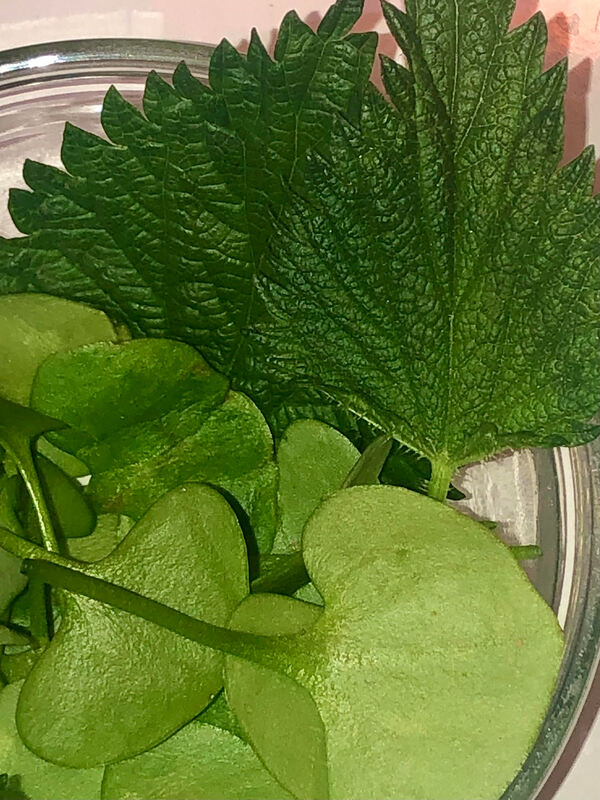|
☘️☘️☘️Considering that today involves the wearing of the green, I'm feeling inspired to share my love of the eating of the greens with a little nod to these Fresh nearly-Spring Stinging Nettles (& succulent Miner’s Lettuce) I just harvested! Making their way into our home & onto our plates, the Miner's Lettuce became part of a vegetarian taco salad while these Nettles were steamed to soften the fine needle-like hairs (trichomes), which are responsible for imparting the warm, tingling “sting” you may feel shortly after they pierce your skin & release a variety of their phytochemicals into you! That said, you can also eat them in raw form too but you may want to take precautions, like gently scraping the trichomes or folding and thoroughly crushing the leaves prior to ingestion. They may also be ground in mortar and pestle or in blender (makes great vibrant green smoothies!) or dried in dehydrator or open air and then cut or ground for future use in making meals (pesto for zoodles, lasagna, calzones, etc.) in making tea/infusions, tinctures, or in other deceptively nutritious and delicious culinary creations! More on this later as I'm feeling inclined to eventually compile a recipe book to share with my clients as part of a nutrition consulting package or as a stand alone item to share with all!
Now, because I didn’t have gloves with me on my walk, I actually handled these with bare hands & never got ‘stung’ but, if I did, I would have simply sought some nearby-growing Dock leaves (or grabbed some from the Dock growing in our yard once I returned home) & then crushed a few leaves to rub on the affected area for use as an 'antidote' of sorts, to help combat and neutralize the sensation (which I liken to a pulsing pins and needles feeling). In many instances, I just deal with my brushes with Nettles. I don’t find the sensation to be very offensive and am a big proponent of mind over matter so generally use perspective and a little deep breathing to help offset the stress created by some of life's more challenging situations. That said, I do honor and respect that each and every one of us is a biochemically unique individual so, while I can find ease despite being 'stung', I realize that this may not be someone else’s experience-- yet or ever! Nevertheless, handling with ‘kid gloves’ & most any thick hand protection should do wonders in helping one avoid the 'burn'--or however one might classify the experience of having been 'bit' by this particular plant-- and to comfortably harvest the potentially-prickly but deliciously nutrition benefits of nature's bounty! Note: don’t forget the wrists and forearms with a thick long sleeve shirt or other protection, if you're concerned about exposure and Nettles' 'sting'! Of course, I must mention that, in order to help leave no trace-- while leaving some for others and some for yourself for next harvest-- it's vital to only cut or harvest the top sets of leaves and to generally follow the practice of taking no more than 10% (or less) of what you see around you. While the world is our oyster, we humans can be far more arrogant and self-serving than is wise for our own good and long-term health of our ecosystems so, again, please be respectful, tread lightly and give thanks, while you're at it, to plant and planet while sustainably reaping the goodness of the seeds that have been sown and nourished by the birds and other creatures who also depend upon Mother Nature's life-giving sustenance. Onto the nutritious benefits of the gentle reaping of nature's bounty. Nettles leaves, especially when harvested in early Spring, are a particularly nice source of vitamins, minerals and other phytochemicals, including but not limited to beta carotene, vitamin C, vitamin K, vitamin B2, Calcium, Magnesium, Potassium and Quercetin. Because of its lovely nutrient profile, Nettles is known for many research-based results, which include lending a hand (or leaf) in: conferring seasonal allergy relief, promoting joint comfort, assisting with enlarged prostate and providing numerous other science-backed benefits*. Plus, they're a low calorie, nutrient-rich food choice which may help you feel full and satisfied, while reducing food cravings, which are often born of nutrient deficiencies as our bodies tell us, "Feed Me!" but are often met by nutrient-poor foods which only further perpetuate blood sugar spikes, crashes and unhealthy cravings. If you enjoy Nettles like I do, please let me know in the comments section below how you prefer to use them, as I'm always interested in hearing how others use Earth's harvests to harmoniously support a healthy existence! *References Ghorbanibirgani, A., Khalili, A., & Zamani, L. (2013, January). The efficacy of stinging nettle (urtica Dioica) in patients with benign Prostatic Hyperplasia: A randomized double-blind study in 100 patients. Retrieved March 17, 2021, from https://www.ncbi.nlm.nih.gov/pmc/articles/PMC3589769/ Randall, C., & H. et. al. (2000, June 1). Randomized controlled trial of nettle sting for treatment of base-of-thumb pain. Retrieved March 17, 2021, from https://journals.sagepub.com/doi/abs/10.1177/014107680009300607 Mittman P. Randomized, double-blind study of freeze-dried Urtica dioica in the treatment of allergic rhinitis. Planta Med. 1990 Feb;56(1):44-7. doi: 10.1055/s-2006-960881. PMID: 2192379. Although many of us choose to ingest and stay well through the benefits of the vegetable/plant kingdom, it is always suggested to consult with your health care professional(s) and pharmacist(s) who are familiar with your unique health history and health status, before making significant dietary changes or including new supplements to your diet— especially if you're choosing to use Nettles or other plants/herbs in supplement form, are on medication, and/or have any specific medical condition-- to help ensure there are no potential interactions or contraindications with any of your conditions or medications.
0 Comments
|
AuthorUnless otherwise credited, all work is the original content of Amy Pereira Archives
May 2024
Categories
All
|

 RSS Feed
RSS Feed